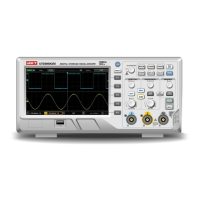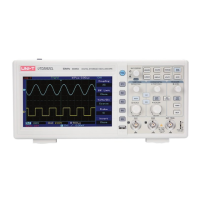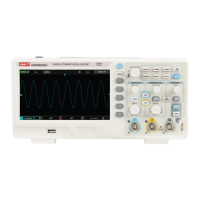UTD2000 Series User Manual
34
■ External trigger: This type of trigger source can be used not only in collecting data in
two channels but also in triggering the third channel at the same time. For example, the
external clock or the signal from circuit to be measured can be served as trigger source.
EXT trigger source use the external trigger signal connected to EXT TRIG junction. EXT
can directly use the signal, the EXT can be used when the trigger level of signal ranges
from -3V to +3V.
■ AC line trigger: It is also called Mains supply. This can be applied to observe the signals
correlated to AC line power to stabilize the synchronization, such as the relation between
lighting equipment and power supply equipment.
(2) Trigger mode: Deciding the behavioral pattern of DSO under no trigger conditions.
Three trigger modes are provided for DSO: auto, normal and single.
■ Auto trigger: When there is no trigger signal, the DSO will automatically perform data
acquisition and the scan base line will be displayed on the screen. DSO will automatically
synchronize with the trigger signal when there is trigger signal.
Attention: when scanning waveform is set as 100ms/div or slower time base, no trigger
signal is allowed under “auto trigger” mode.
■ Normal trigger: Set to normal trigger mode. The DSO will only perform data acquisition
only when trigger conditions are satisfied. When there is no trigger signal, DSO stops data
collection. When there is trigger signal, the scan will be triggered.
■ Single trigger: On single trigger mode, press “Operation” once, the DSO will enter the
status of waiting trigger, when the DSO detects a trigger, it will collect data and display the
collected waveform, and then stop.
(3) Trigger coupling: Trigger coupling decides that what kind of signal components will
be sent to trigger circuit. Coupling types include: DC, AC, low-frequency holdoff and high-
frequency holdoff.
“DC” let all components of signal pass through.
“AC” block “DC” component and attenuate signals under 10Hz.
“Low-frequnecy holdoff” block DC components and attenuate low-frequency
components under 80kHz.
“High-frequency holdoff” attenuate high-frequency component over 80kHz.
“Noise holdoff” can hold off the high-frequency noise in the signal and reduce the
probability of mis-trigger.
(4) Pretrigger/delay trigger
Data collected before/after the trigger. The trigger position is usually set in the horizontal
center of the screen, 7div or 8div pretrigger/delay information can be viewed. If you want
to view more pretrigger information, you could adjust the horizontal position of waveform
by rotating horizontal position. By observing pretrigger data, you can view the waveform
before triggering. For example, the glitch can be captured at the moment of starting the
circuit, you can find out the cause of glitch by observing and anlyze the pretrigger data.
